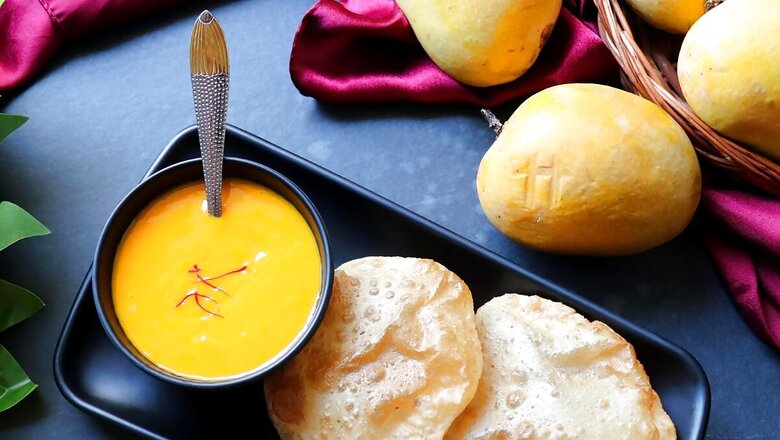
views
How is it that this small, oval-shaped fruit with golden-orange skin, so soft to the touch, its deep orange flesh tender and juicy, makes hearts flutter every time summer arrives in Maharashtra and the rest of the country?
This creamy fruit, with hints of apricot and peach is sweet, juicy, with a silken pulpy flesh that melts in your mouth, leaving a rich aftertaste, that owns a flavour so unique and delicious that is often called a nectar from the gods. Mango is not just any ordinary fruit, but literally symbolises, sweetness, pleasure, joy and prosperity.
In India, mangoes have been cultivated for over 4,000 years and are an intrinsic part of our culture. Their arrival in the markets signals the start of the summer season. Unfortunately, as soon as the first mangoes arrive in the markets, it leads to an immediate surge in price in Mumbai, and this fruit triumphantly arrives as unaffordable for most. A dozen mangoes can cost as much as Rs 2,600, it’s only as the produce increases with its several varieties through the summer, that we poor people can start affording them.
You cannot ignore or evade the arrival of the mango season because the fruit can be seen everywhere. They are in your face. In my area, the neighbourhood paan-walla and cigarette shop, the small kirana shop, the bakery, hardware shops, cycle repair shop, even the plumbers and car-repair shops, turn into mango sellers overnight.
One fine morning, all these shopkeepers change their professions, and their shops are lined with warm hay and are stocked with cartons, boxes and cases of mangoes. Nearly every shop-front in my middle class Dadar neighbourhood is resplendent with the king of fruit displayed in rows and piles from ceiling to pavement in all its Ratnagiri glory. Out of these, some fruits are still green and are awaiting to ripen, while some have already turned a golden yellow, and the choicest ones, of course, have peaked with little red and orange tips.
Come summer and people start looking for their favourite varieties of mangoes. Mumbai, for instance, offers a wide range of mango varieties, starting with the King Alphonso, or Hapus, which is known for its rich flavour, sweetness, and aroma. Then comes my favourite, the Payri, it is a smaller, softer and more fibrous fruit with a noticeable sour bite. Its skin is often green with a hint of red. Great to make Amraas and juice. I, however, like to nip the top off, gently massage the mango in my palm till it gets soft and warm, and then just suck all the juice out.
When the Alphonso is gone for the year, the Totapuri appears from June to July. It’s shaped like the beak of a parrot, and so the name, tota or parrot. The flesh is a lighter colour and it’s not too sweet. If you have the guts, add some salt and red chili powder. It’s a knock out combination. Neelam mangoes are grown in the Nashik region of Maharashtra and are known for their sweet taste and firm texture. Rajapuri mangoes are large and have a bright yellow skin with a sweet and tangy taste. Langra and Baganapalli are the non-Maharashtrian mangoes. Langra comes from Haryana, Bihar, Uttar Pradesh and West Bengal and Baganapalli from Hyderabad and from Andhra Pradesh. I’m sorry but we hardcore mango lovers of Maharashtra look down on these immigrants with a glimmer of contempt.
The most popular way of eating mango, besides just slicing it up and consuming it, or it’s just Aamras Poori time. It’s actually an idiosyncratic combination. A chilled sweet fruit pulp eaten with hot deep fried savoury pooris? Yet it works in this really free-spirited way.
We at home eat Aamras with freshly baked bread, not the kind you buy in a bakery. It’s home-baked, cottage sourdough which is leavened with a homemade starter or yeast. The aromas while baking may sometimes seem offensive to the uninitiated, but it comes off hot, and glorious especially when eaten with cold Aamras. Otherwise for Aamras Puri, any Gujju Thali joint will do. Skip the bhakras, phulkas, puran polis, rice, khichdi and all other forms of carbohydrates. Just let them fill your platter with the farsaan, vegetables, dals and pooris. At least half a dozen pooris to start with. One big katori of Aamras and then dip the poori in Aamras and hit your high notes.
Restaurants and patisseries too will start their Mango extravaganzas. Fresh mangoes with cream, Mango Gateaux, Mango Mousse, Mango Panna Cotta, Fresh Mango Tarts, Mango Cupcakes, Mango Cheesecakes, Mango Brulee, Mille Feuille and more.
For me, I’m going to indulge in one Thali with Aamras, and then head straight to Seefah in Bandra. There I will have a bowl of fiery Prawn Green Curry on Jasmine Rice, and then settle down to slowly savour their, Sticky Rice with Mango.
Kunal Vijayakar is a food writer based in Mumbai. He tweets @kunalvijayakar and can be followed on Instagram @kunalvijayakar. His YouTube channel is called Khaane Mein Kya Hai. The views expressed in this article are those of the author and do not represent the stand of this publication.
Read all the Latest Lifestyle News here




















Comments
0 comment